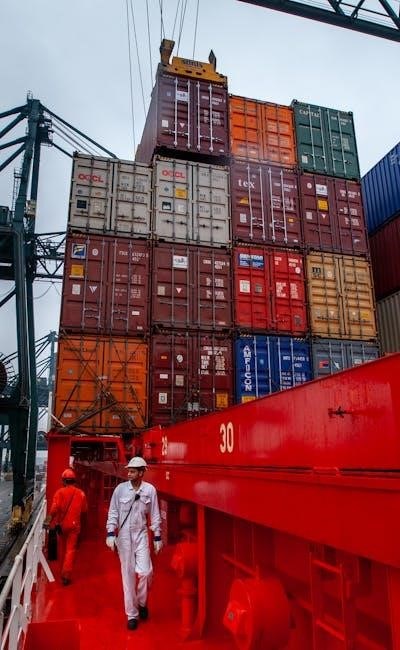
The Core Issue: Unfair Trade Practices and Market Distortion
Dumping‚ a critical concern in global trade‚ represents unfair trade practices that significantly contribute to market distortion.
It occurs when goods are exported at a price lower than their normal value‚ often below their production cost or domestic selling price.
This practice isn’t simply about lower prices; it’s a strategic move to gain an undue competitive advantage‚ potentially harming the domestic industry
in importing countries. The resulting economic impact can be severe‚ leading to job losses and reduced investment.
Understanding the mechanics of dumping – calculating the dumping margin – is crucial. This margin‚ alongside the assessment of injury margin
to the domestic producers‚ forms the basis for applying trade remedies‚ specifically anti-dumping duties.
Furthermore‚ export subsidies‚ often used in conjunction with dumping‚ necessitate the application of countervailing duties. These actions are
governed by international trade law and overseen by the WTO‚ aiming to ensure fair competition and level the playing field.
Recognizing and addressing dumping is vital for maintaining a stable and equitable global trade environment‚ preventing the erosion of trade barriers
and fostering sustainable economic growth. A thorough investigation‚ supported by robust evidence‚ is paramount.
Unfair trade practices‚ particularly dumping and subsidized exports‚ fundamentally disrupt market distortion within the global trade system.
These actions aren’t merely competitive pricing; they represent deliberate strategies to undermine fair competition and secure an artificial competitive advantage.
Dumping – selling goods below cost or domestic market value – creates an uneven playing field‚ potentially causing significant economic impact on the domestic industry
of importing nations. This can manifest as reduced profits‚ production cuts‚ and even business closures. Coupled with export subsidies‚ the effect is amplified.
The application of trade remedies‚ such as anti-dumping duties and countervailing duties‚ is crucial for mitigating these distortions. However‚ effective implementation
requires a robust legal framework grounded in international trade law and overseen by the WTO. Accurate customs valuation is also essential.
A key element in determining the legitimacy of these remedies lies in calculating the dumping margin and assessing the resulting injury margin to domestic producers.
This necessitates a thorough investigation‚ relying on verifiable evidence to demonstrate the existence of unfair trade practices and their detrimental effects.
Addressing these issues demands a commitment to compliance with international regulations and a proactive approach to identifying and countering trade barriers.
Ultimately‚ fostering a level playing field is vital for sustainable global trade and long-term economic prosperity.
Navigating the Legal Framework of Trade Remedies
Trade remedies‚ governed by international trade law and the WTO‚ provide recourse against unfair trade practices like dumping.
Anti-dumping duties and countervailing duties are key tools.
A successful case requires a rigorous investigation‚ presenting compelling evidence of dumping margin and injury margin to the domestic industry.
Compliance with procedural requirements is paramount. The legal framework demands precise customs valuation and adherence to established norms.
Anti-Dumping Duties and Countervailing Duties: Your Protective Measures
Anti-dumping duties are specifically imposed to offset the dumping margin – the difference between the export price and the normal value in the exporting country. These duties aim to restore fair competition by neutralizing the price advantage gained through unfair trade practices. The calculation relies heavily on internationally accepted customs valuation methods‚ ensuring transparency and objectivity.
Countervailing duties‚ conversely‚ address export subsidies provided by foreign governments. These subsidies artificially lower production costs‚ creating a similar market distortion as dumping. Determining the appropriate countervailing duty requires a detailed analysis of the subsidy’s impact‚ again utilizing standardized methodologies aligned with WTO guidelines.
Effectively‚ both duty types function as trade remedies‚ protecting the domestic industry from material injury caused by these practices. The imposition of these tariffs isn’t punitive‚ but rather corrective‚ aiming to level the playing field and safeguard economic impact. A robust legal framework‚ underpinned by consistent international trade law‚ is essential for their legitimate application. Thorough investigation and demonstrable evidence are crucial for successful implementation‚ ensuring compliance with standards organizations’ recommendations and promoting harmonization of practices globally.
Proactive Strategies for Mitigating Dumping Risks
The Role of International Standards in Establishing Fair Value
Customs Valuation‚ Quality Control‚ and the Pursuit of Harmonization
International standards‚ like those from ISO‚ are vital for accurate customs valuation and defining ‘normal value’ in anti-dumping duties cases.
Consistent quality control processes‚ adhering to globally recognized standards organizations’ guidelines‚ ensure comparable product assessments. This minimizes price discrimination and supports fair comparisons.
Harmonization of valuation methods and product definitions reduces ambiguity‚ fostering transparency and facilitating effective trade remedies against unfair trade practices.



This is a very clear and concise explanation of a complex issue. It